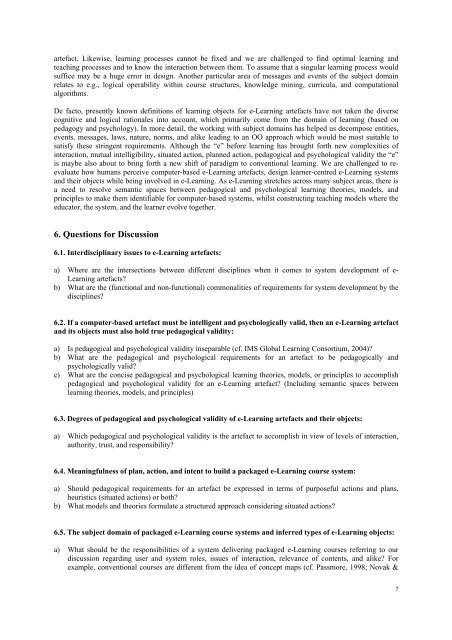Ontologies and the Semantic Web for E-learning - Educational ...
Ontologies and the Semantic Web for E-learning - Educational ...
Ontologies and the Semantic Web for E-learning - Educational ...
Create successful ePaper yourself
Turn your PDF publications into a flip-book with our unique Google optimized e-Paper software.
artefact. Likewise, <strong>learning</strong> processes cannot be fixed <strong>and</strong> we are challenged to find optimal <strong>learning</strong> <strong>and</strong><br />
teaching processes <strong>and</strong> to know <strong>the</strong> interaction between <strong>the</strong>m. To assume that a singular <strong>learning</strong> process would<br />
suffice may be a huge error in design. Ano<strong>the</strong>r particular area of messages <strong>and</strong> events of <strong>the</strong> subject domain<br />
relates to e.g., logical operability within course structures, knowledge mining, curricula, <strong>and</strong> computational<br />
algorithms.<br />
De facto, presently known definitions of <strong>learning</strong> objects <strong>for</strong> e-Learning artefacts have not taken <strong>the</strong> diverse<br />
cognitive <strong>and</strong> logical rationales into account, which primarily come from <strong>the</strong> domain of <strong>learning</strong> (based on<br />
pedagogy <strong>and</strong> psychology). In more detail, <strong>the</strong> working with subject domains has helped us decompose entities,<br />
events, messages, laws, nature, norms, <strong>and</strong> alike leading to an OO approach which would be most suitable to<br />
satisfy <strong>the</strong>se stringent requirements. Although <strong>the</strong> “e” be<strong>for</strong>e <strong>learning</strong> has brought <strong>for</strong>th new complexities of<br />
interaction, mutual intelligibility, situated action, planned action, pedagogical <strong>and</strong> psychological validity <strong>the</strong> “e”<br />
is maybe also about to bring <strong>for</strong>th a new shift of paradigm to conventional <strong>learning</strong>. We are challenged to reevaluate<br />
how humans perceive computer-based e-Learning artefacts, design learner-centred e-Learning systems<br />
<strong>and</strong> <strong>the</strong>ir objects while being involved in e-Learning. As e-Learning stretches across many subject areas, <strong>the</strong>re is<br />
a need to resolve semantic spaces between pedagogical <strong>and</strong> psychological <strong>learning</strong> <strong>the</strong>ories, models, <strong>and</strong><br />
principles to make <strong>the</strong>m identifiable <strong>for</strong> computer-based systems, whilst constructing teaching models where <strong>the</strong><br />
educator, <strong>the</strong> system, <strong>and</strong> <strong>the</strong> learner evolve toge<strong>the</strong>r.<br />
6. Questions <strong>for</strong> Discussion<br />
6.1. Interdisciplinary issues to e-Learning artefacts:<br />
a) Where are <strong>the</strong> intersections between different disciplines when it comes to system development of e-<br />
Learning artefacts?<br />
b) What are <strong>the</strong> (functional <strong>and</strong> non-functional) commonalities of requirements <strong>for</strong> system development by <strong>the</strong><br />
disciplines?<br />
6.2. If a computer-based artefact must be intelligent <strong>and</strong> psychologically valid, <strong>the</strong>n an e-Learning artefact<br />
<strong>and</strong> its objects must also hold true pedagogical validity:<br />
a) Is pedagogical <strong>and</strong> psychological validity inseparable (cf. IMS Global Learning Consortium, 2004)?<br />
b) What are <strong>the</strong> pedagogical <strong>and</strong> psychological requirements <strong>for</strong> an artefact to be pedagogically <strong>and</strong><br />
psychologically valid?<br />
c) What are <strong>the</strong> concise pedagogical <strong>and</strong> psychological <strong>learning</strong> <strong>the</strong>ories, models, or principles to accomplish<br />
pedagogical <strong>and</strong> psychological validity <strong>for</strong> an e-Learning artefact? (Including semantic spaces between<br />
<strong>learning</strong> <strong>the</strong>ories, models, <strong>and</strong> principles)<br />
6.3. Degrees of pedagogical <strong>and</strong> psychological validity of e-Learning artefacts <strong>and</strong> <strong>the</strong>ir objects:<br />
a) Which pedagogical <strong>and</strong> psychological validity is <strong>the</strong> artefact to accomplish in view of levels of interaction,<br />
authority, trust, <strong>and</strong> responsibility?<br />
6.4. Meaningfulness of plan, action, <strong>and</strong> intent to build a packaged e-Learning course system:<br />
a) Should pedagogical requirements <strong>for</strong> an artefact be expressed in terms of purposeful actions <strong>and</strong> plans,<br />
heuristics (situated actions) or both?<br />
b) What models <strong>and</strong> <strong>the</strong>ories <strong>for</strong>mulate a structured approach considering situated actions?<br />
6.5. The subject domain of packaged e-Learning course systems <strong>and</strong> inferred types of e-Learning objects:<br />
a) What should be <strong>the</strong> responsibilities of a system delivering packaged e-Learning courses referring to our<br />
discussion regarding user <strong>and</strong> system roles, issues of interaction, relevance of contents, <strong>and</strong> alike? For<br />
example, conventional courses are different from <strong>the</strong> idea of concept maps (cf. Passmore, 1998; Novak &<br />
7
















